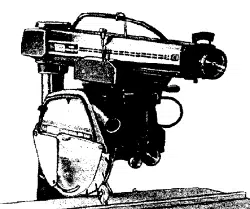Loading ...
Loading ...
Loading ...

trouble shooting
Make sure the teeth of the ANTIKtCKBACK pawls are
always sharp. Replace if not sharp.
TROUBLE SHOOTING CHART
NOTE: Motors used on wood-working tools are particularly and should be blown out or "vacuumed'" frequently to
susceptible to the accumulation of sawdust and wood chips prevent interference with normal motor ventilation.
TROUBLE PROBABLE CAUSE REMEDY
Motor will not run. 1. Protector open; circuit 1.
broken.
2. Low voltage.
Motor will not run and
fuses "'B LOW."
Motor fails to develop
full power. (Power output
of motor decreases rapidly
with decrease in voltage at
motor terminals. For
example: a reduction of
10% in voltage causes a
reduction of 19% in
maximum power output of
which the motor is capable,
while a reduction of 20%
in voltage causes a reduc-
tion of 36% in maximum
power output.)
Motor starts slowly or
fails to come up to full
speed.
Motor overheats.
Starting relay in motor
will not operate.
1, Short circuit in line cord or
plug.
2. Short circuit in motor terminal
box, or loose connections.
3. Incorrect fuses in power line.
1. Power line overloaded with
lights, appliances and other
motors.
2. Undersize wires or circuit too
long.
3. General overloading of power
company's facilities. (In many
sections of the country, deman_
for electrical power exceeds
the capacity of existing gen-
erating and distribution
systems.)
1. Low Voltage - will not trip
relay.
2. Starting relay not operating.
1. Motor overloaded.
2. Improper cooling. (Air circula-
tion restricted through motor
due to sawdust, etc.)
1. Burned relay contacts (due to
extended hold in periods
caused by low line voltage,
etc.)
2. Open relay coil.
3. Loose or broken connections
in motor terminal box.
4. Shorted capacitor.
Reset protector by pushing on red button, located
on top of motor junction box (indicated by audible
click).
2. Check power line for proper voltage.
1. Inspect line cord and plug for damaged insulation
and shorted wires.
! 2. Inspect all terminals in motor terminal box for loose
or shorted terminals or worn insulation on wires.
3. Install correct fuses.
1.
Reduce the line load.
2. Increase wire sizes, or reduce length of wiring.
3. Request a voltage check from the power company.
1. Correct low voltage condition.
2. Replace the relay.
1. Correct overload condition.
2. Clean out sawdust to provide normal air circulation
through motor.
1. Replace relay and check line voltage.
2. Replace relay.
3. Check and repair wiring.
4. Test capacitors and replace if defective.
CONTINUED ON NEXT PAGE
26
Loading ...
Loading ...
Loading ...
